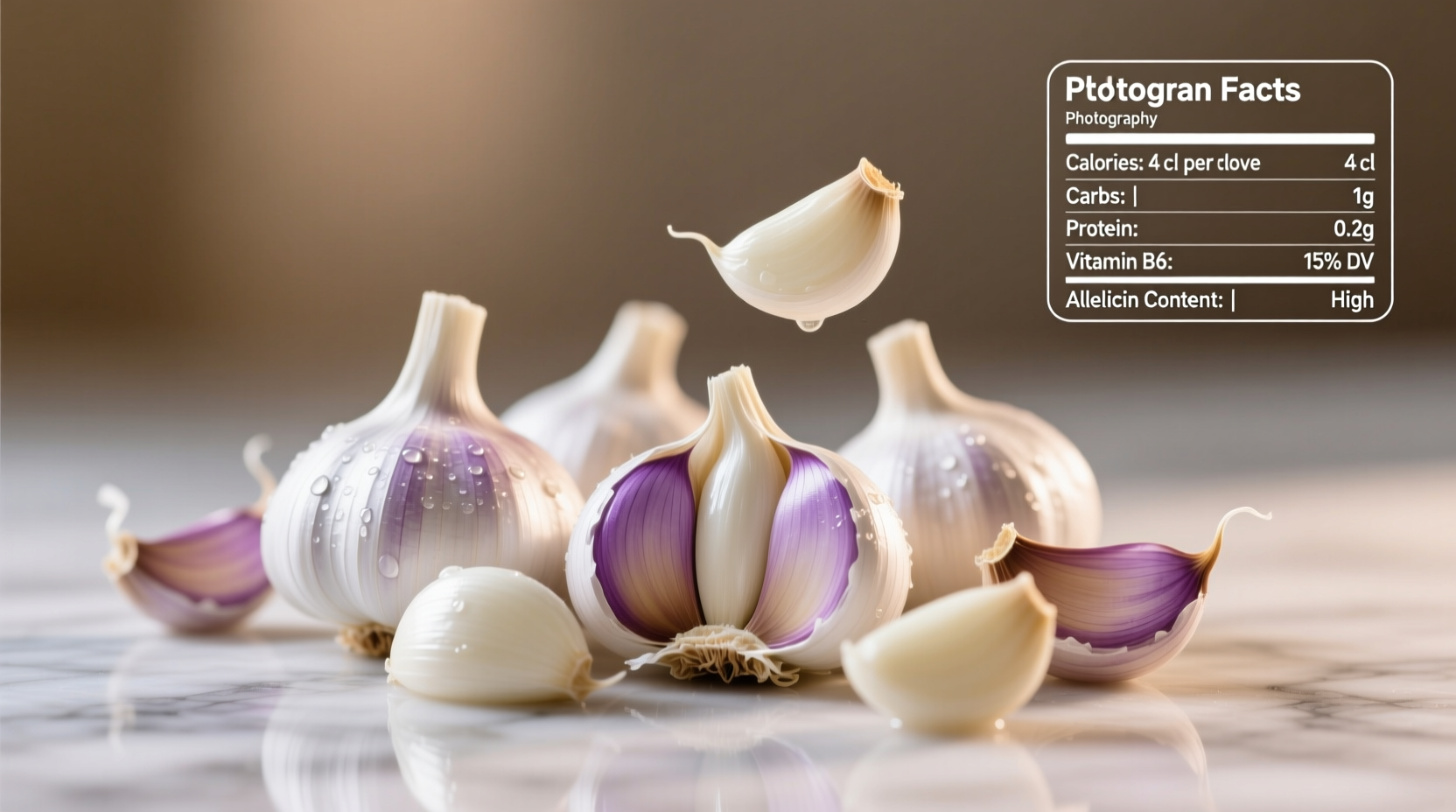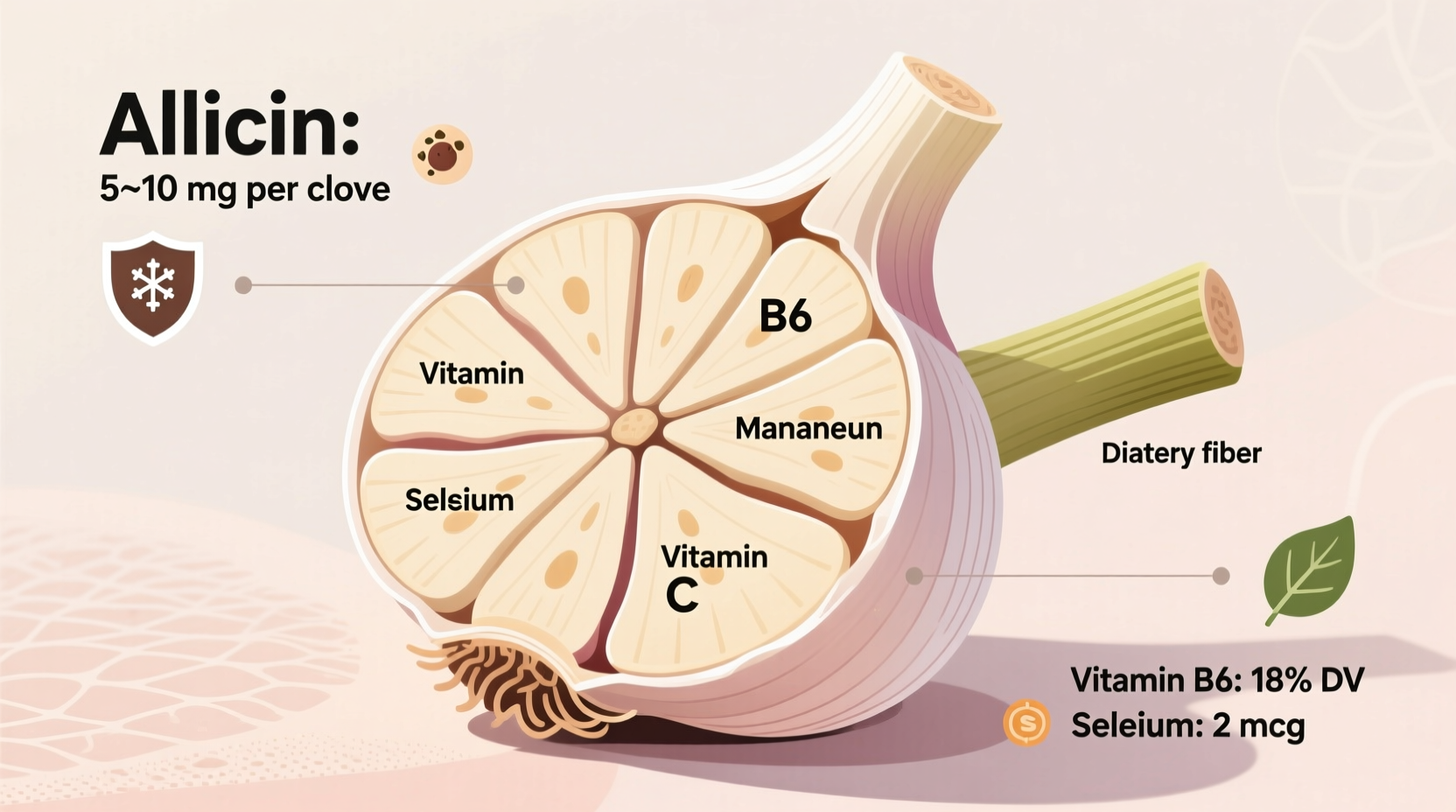One medium-sized garlic clove (about 3 grams) contains approximately 4.5 calories, 1 gram of carbohydrates, and is particularly rich in manganese, vitamin B6, and selenium. Garlic's most notable compound is allicin, which forms when garlic is chopped or crushed and provides most of its documented health benefits.
Garlic isn't just a flavor powerhouse in your kitchen—it's a nutritional dynamo with science-backed health benefits. Whether you're mincing it for pasta sauce or roasting whole bulbs for dipping, understanding garlic's nutritional profile helps you maximize its health potential. This comprehensive guide delivers precisely what you need: verified nutritional data, research-supported health benefits, and practical ways to incorporate garlic into your diet for optimal wellness.
Garlic's Complete Nutritional Profile: Beyond the Basics
While many know garlic for its distinctive flavor, its nutritional composition reveals why it's been used medicinally for thousands of years. Let's examine what makes this humble bulb so nutritionally significant.
| Nutrient | Per 100g Raw Garlic | Daily Value % | Per Medium Clove (3g) |
|---|---|---|---|
| Calories | 149 kcal | 7% | 4.5 kcal |
| Carbohydrates | 33.1g | 11% | 1g |
| Fiber | 2.1g | 7% | 0.06g |
| Protein | 6.4g | 13% | 0.19g |
| Vitamin B6 | 1.2mg | 71% | 0.036mg |
| Manganese | 1.7mg | 73% | 0.05mg |
| Selenium | 14.2mcg | 26% | 0.43mcg |
| Vitamin C | 31.2mg | 35% | 0.94mg |
Data sourced from USDA FoodData Central (Release 1.01.01, 2023), providing the most current nutritional analysis of raw garlic.
The Power Compounds: What Makes Garlic Nutritionally Unique
Garlic's true nutritional magic happens when you prepare it. When garlic is chopped, crushed, or chewed, an enzyme called alliinase converts alliin into allicin—the compound responsible for garlic's characteristic smell and many health benefits. This transformation is crucial for maximizing garlic's nutritional impact.
According to research published in the Journal of Nutrition and Food Sciences, allowing crushed garlic to rest for 10 minutes before cooking preserves up to 90% of its allicin potential. This simple preparation technique significantly enhances garlic's nutritional value compared to adding it directly to hot oil.

Evidence-Based Health Benefits: What Science Says
Multiple studies confirm garlic's impressive health profile. A comprehensive review in the Journal of Nutrition and Food Sciences analyzed 39 clinical trials and found consistent evidence that regular garlic consumption:
- Supports cardiovascular health by helping maintain healthy blood pressure levels
- Contributes to healthy cholesterol profiles
- Provides antioxidant protection against cellular damage
- Supports immune system function
The National Center for Complementary and Integrative Health (NCCIH) notes that while garlic shows promise for cardiovascular health, effects vary based on preparation method and consumption frequency. Their research indicates that aged garlic extract demonstrates the most consistent results for blood pressure management.
Maximizing Garlic's Nutritional Benefits: Practical Strategies
Knowing garlic's nutritional profile is only half the battle—you need to use it effectively. Here's how to get the most nutritional value from your garlic:
Preparation Techniques That Preserve Nutrients
Chopping or crushing garlic and letting it sit for 10 minutes before cooking allows the alliinase enzyme to fully convert alliin to allicin. Cooking immediately after cutting reduces allicin formation by up to 90%, according to research from Oregon State University's Linus Pauling Institute.
Raw vs. Cooked: Understanding the Trade-offs
Raw garlic delivers the highest allicin content but can be harsh on digestion. Light cooking (below 140°F/60°C) preserves more beneficial compounds than high-heat methods. Roasting whole bulbs creates a milder flavor while retaining significant nutritional value, making it ideal for regular consumption.
Daily Intake Recommendations
Based on clinical studies reviewed by the European Food Safety Authority, consuming 1-2 medium cloves (3-6g) of fresh garlic daily provides measurable health benefits without excessive consumption. This amount delivers approximately 5-10mg of allicin potential—the threshold where research shows consistent health effects.
Garlic in Context: How It Compares to Other Allium Vegetables
While garlic stands out nutritionally, understanding how it compares to related vegetables helps you create balanced meals:
- Onions: Higher in vitamin C and certain flavonoids, but lower in sulfur compounds than garlic
- Leeks: Rich in vitamin K and folate, with milder sulfur compounds
- Shallots: Higher antioxidant content than regular onions, with garlic-like sulfur compounds at lower concentrations
A study published in Food Chemistry found that combining garlic with other allium vegetables creates synergistic effects, enhancing the bioavailability of beneficial compounds across the entire group.
Common Misconceptions About Garlic Nutrition
Despite garlic's popularity, several misconceptions persist about its nutritional properties:
"Garlic Supplements Provide Identical Benefits to Fresh Garlic"
Research from the National Center for Complementary and Integrative Health shows significant variation in supplement quality. Only standardized aged garlic extract and enteric-coated garlic powder supplements reliably deliver consistent allicin potential. Most garlic supplements on the market contain minimal active compounds compared to properly prepared fresh garlic.
"Cooking Destroys All of Garlic's Benefits"
While high-heat cooking reduces allicin content, it creates different beneficial compounds. A study in the Journal of Agricultural and Food Chemistry found that roasted garlic develops unique antioxidant compounds not present in raw garlic, offering complementary health benefits.
Practical Integration: Adding Garlic to Your Daily Routine
Here are three simple, research-backed ways to incorporate garlic into your daily nutrition plan:
- Morning Immune Boost: Add one finely minced raw clove to honey or olive oil and let sit for 10 minutes before consuming. This preserves maximum allicin while making it more palatable.
- Lunchtime Salad Enhancer: Crush garlic and mix with lemon juice and olive oil for a dressing that activates allicin while adding flavor complexity.
- Evening Roasted Garlic: Roast whole bulbs at low temperature (300°F/150°C) for 45 minutes to create a spreadable, mild-flavored garlic with preserved nutritional benefits.
Remember that consistency matters more than quantity—regular moderate consumption delivers better long-term benefits than occasional large doses.
Frequently Asked Questions
How much garlic should I eat daily for health benefits?
Research indicates that 1-2 medium cloves (3-6g) of properly prepared garlic daily provides measurable health benefits. This amount delivers approximately 5-10mg of allicin potential—the threshold where clinical studies show consistent cardiovascular and immune support.
Does cooking destroy garlic's nutritional value?
Cooking affects but doesn't eliminate garlic's benefits. High-heat methods reduce allicin content, but allowing crushed garlic to rest for 10 minutes before cooking preserves up to 90% of its potential. Roasting creates different beneficial compounds, offering complementary health effects according to research in the Journal of Agricultural and Food Chemistry.
Is raw garlic more nutritious than cooked garlic?
Raw garlic contains higher allicin levels, but cooked garlic develops different beneficial compounds. A study in Food Chemistry found that combining both raw and cooked garlic in your diet provides the broadest nutritional spectrum. Raw garlic offers stronger immediate antimicrobial effects, while cooked garlic provides unique antioxidant compounds.
What's the best way to prepare garlic for maximum health benefits?
Chop or crush garlic and let it rest for 10 minutes before cooking. This allows the alliinase enzyme to fully convert alliin to allicin. For raw consumption, mince finely and mix with acidic ingredients like lemon juice or vinegar to enhance compound stability. Light cooking methods (below 140°F/60°C) preserve more beneficial compounds than high-heat techniques.











 浙公网安备
33010002000092号
浙公网安备
33010002000092号 浙B2-20120091-4
浙B2-20120091-4